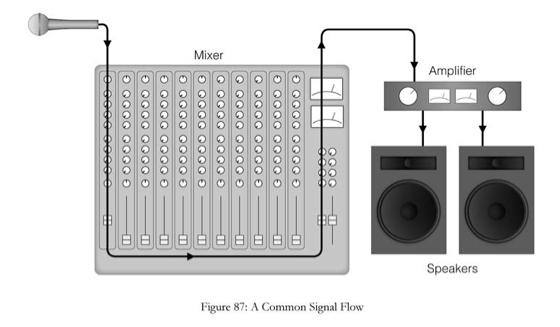Understanding signal flow can help you avoid common problems and get the best sound out of your gear. This post is a clear explanation and helpful overview of the topic from Mark Garrison’s book Encyclopedia of Home Recording.
Signal flow is the path taken by an audio signal. Like water, audio signal flows in one direction. An example of a common signal flow would be from the output of a microphone, through the mic cable, to an input on a mixer’s channel strip, then from the output of the mixer to the input of an amplifier, and from the output of an amplifier to a speaker (see Fig. 87).
Troubleshooting becomes much easier with a solid grasp on how the signal is getting from its origin to its destination. In the example above, if no sound was coming out of the speaker, finding the problem would be a matter of following the signal path back to find where the signal stops. So, if the amplifier was not receiving any signal, but the mixer is definitely sending signal out, the problem is probably the cable that connects them. If the input of the mixer is receiving signal and there is no signal coming out of the mixer, the problem must be somewhere in the mixer (perhaps the channel is muted, or the volume turned down).

With a firm grasp of signal flow also comes the ability to use more complex routing. A more complex example of signal flow would be using one mixer to record and play back four tracks on a four-track recorder (see Fig. 88). In this situation the signal would start with four microphones, through the mic cables to four channels on the mixing board, those four channels are then routed to four separate outputs, which are connected to the four inputs of the recorder. To listen back, the four outputs from the recorder are run into four more channels on the mixer, which are assigned to a separate stereo buss. This buss combines the four channels into a stereo pair and sends them to the main outputs of the mixer, which are connected to an amplifier, which in turn is plugged into a pair of speakers.
In the above example, the manner in which the four input channels are run directly to the recording unit will vary depending on the mixing board. Some mixers have direct outputs on each channel for this specific purpose. When direct outputs are not available, unbalanced audio can be output through the insert or, as shown in Fig. 88, the channels can be run in pairs (panned hard left and right) to stereo busses. Either way, it is important to ensure that these channels are not assigned to the master buss.

{excerpt}
Read More